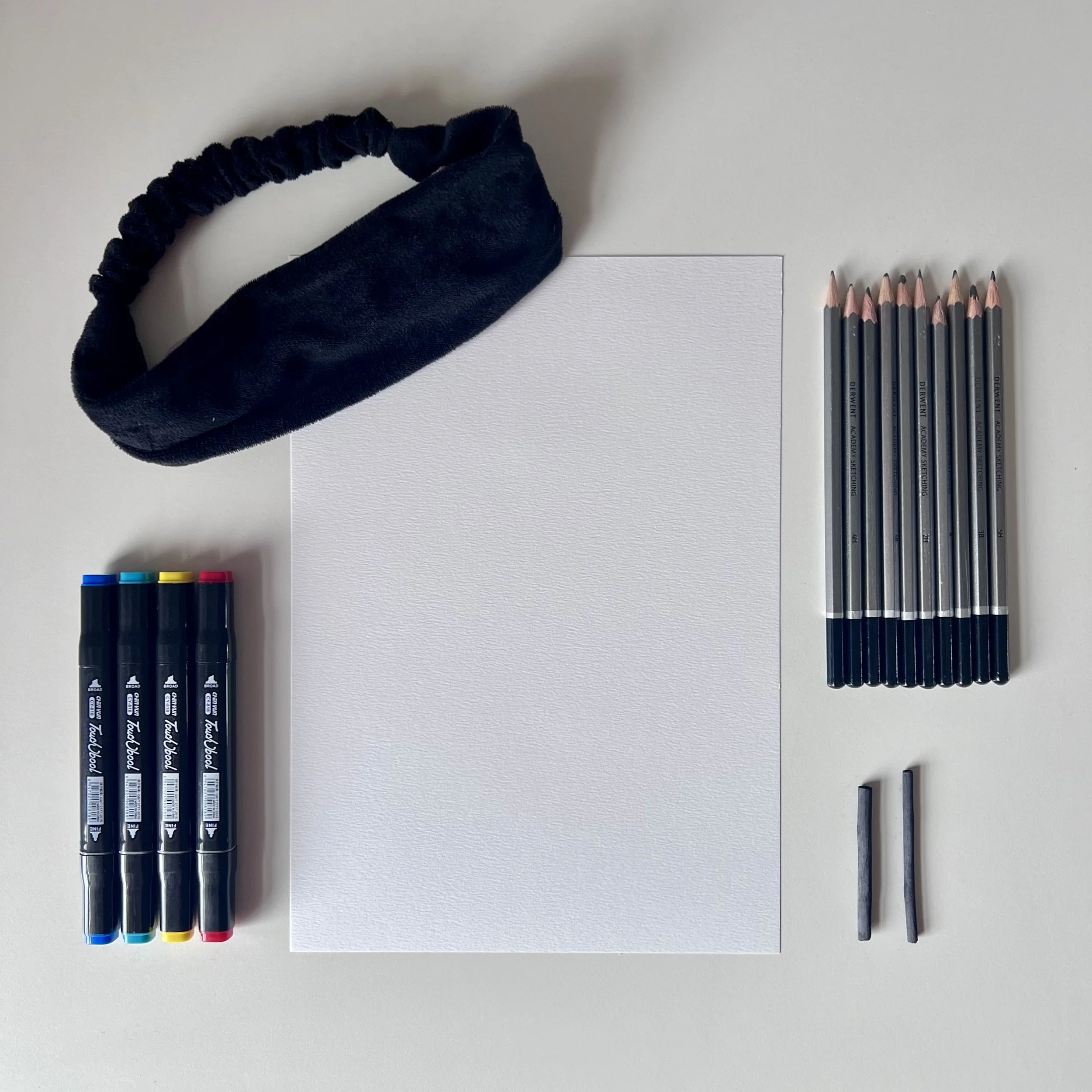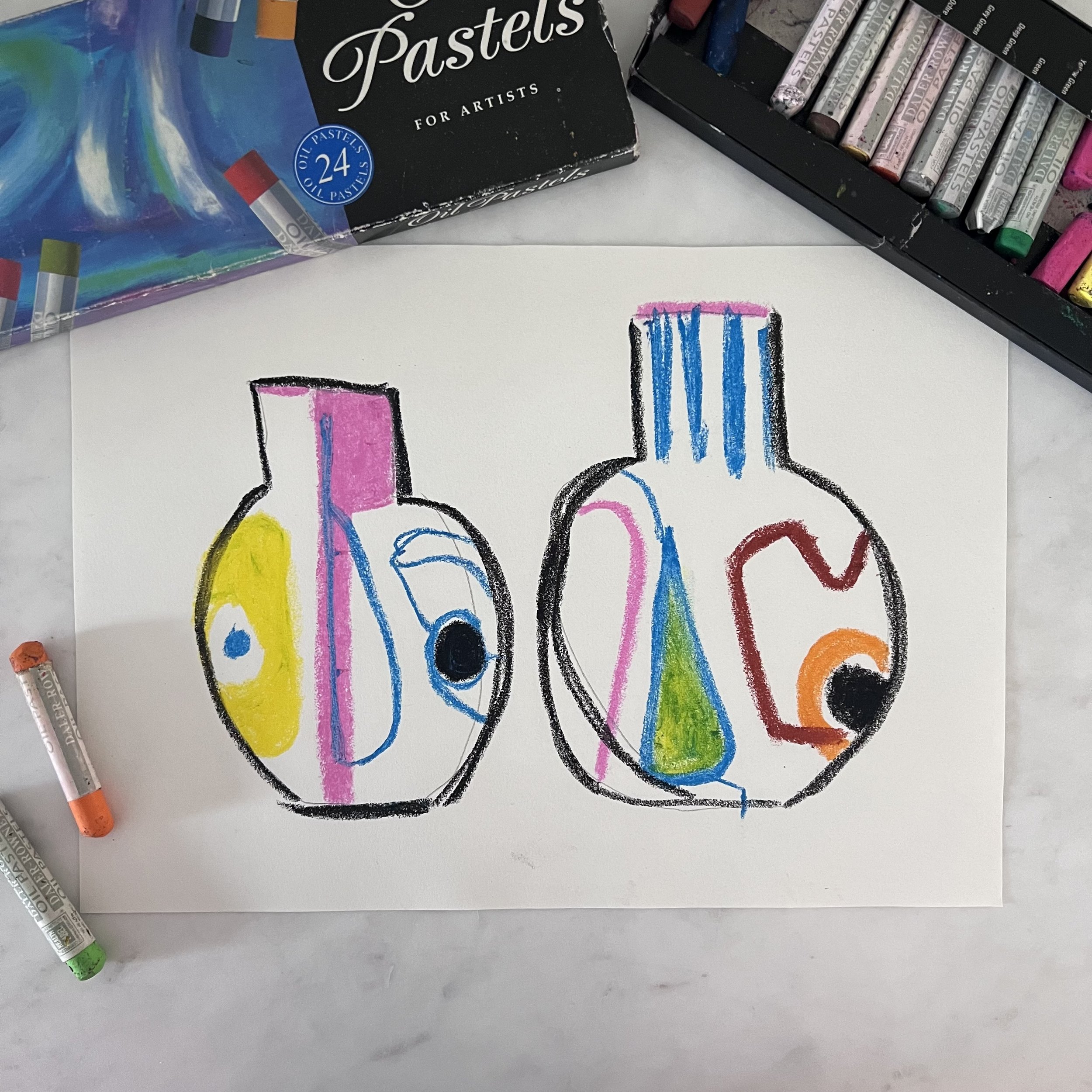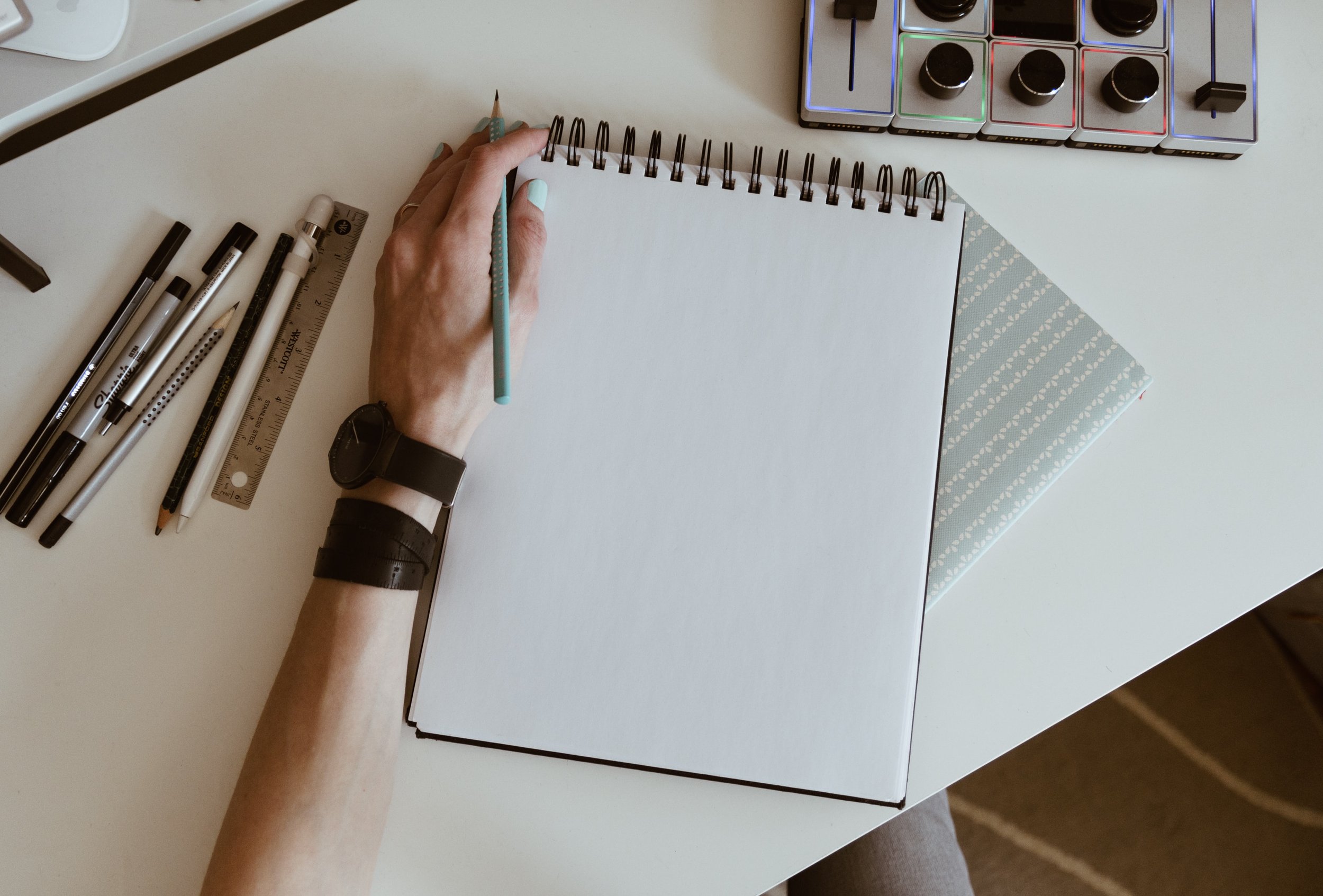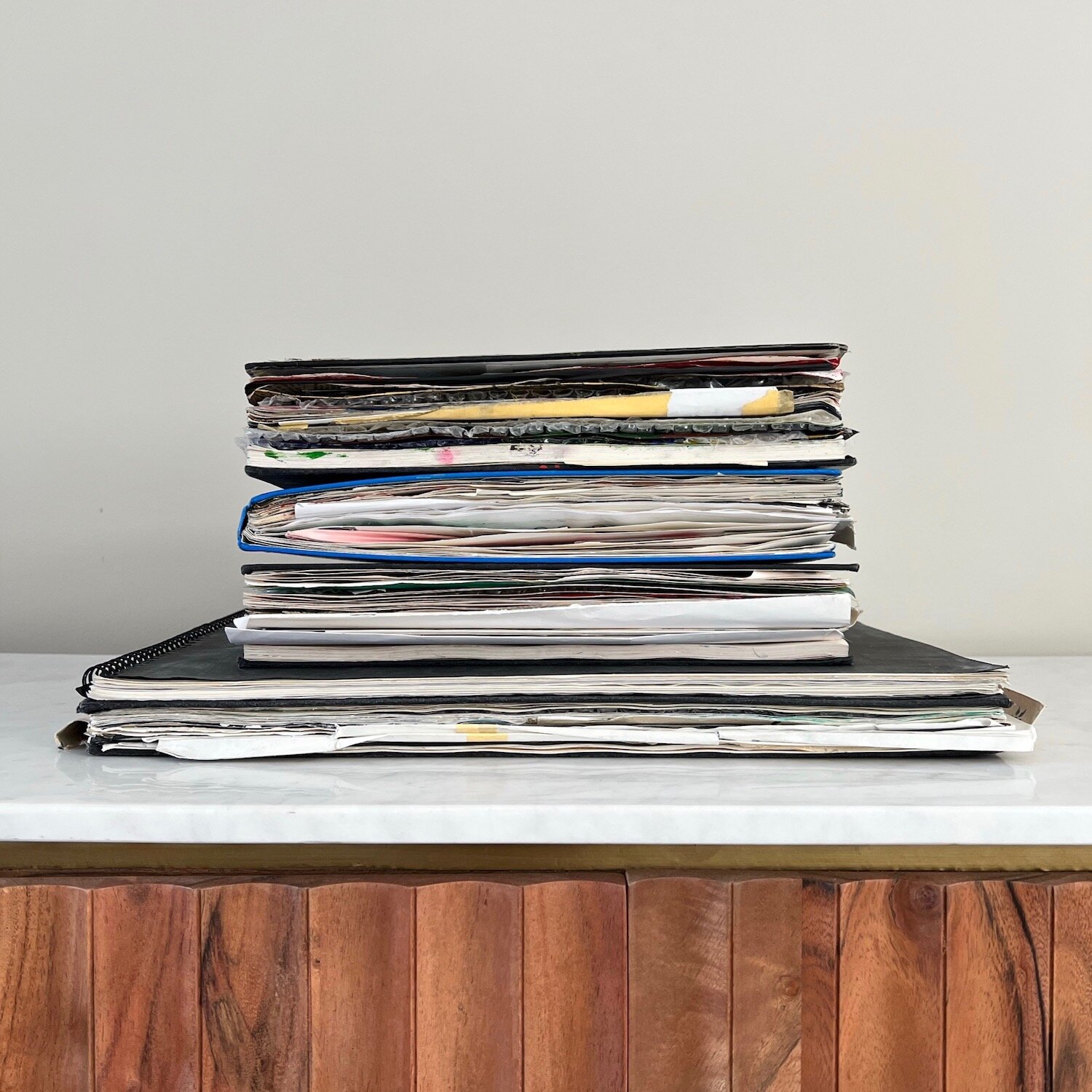The Power of Drawing With Your Eyes Closed
Drawing with your eyes closed, also known as blind drawing, is an intriguing art activity that allows you to tap into your intuition and subconscious mind. Unlike regular observational drawing where you carefully observe and recreate a still life, model or landscape, blind drawing removes your visual senses from the equation.
By drawing with your eyes closed, you are forced to visualise the subject in your mind and allow your hand to move freely across the page.
In this article, I explore the liberating act of drawing with your eyes closed - unlocking a creative activity where imagination meets intuition.
Table of Contents
Overview of Drawing With Your Eyes Closed
Getting Started With Drawing With Your Eyes Closed
Developing Intuition Through Drawing With Your Eyes Closed
Exploring Different Subjects When Drawing With Eyes Closed
Taking Blind Drawing Further With Advanced Techniques
Overview of Drawing With Your Eyes Closed
Blind drawing is quite simple in concept.
The artist closes their eyes fully, visualises the subject in their mind’s eye, and allows their hand holding the drawing tool to move across the paper unrestrained. The hand draws the shapes, lines and figures conjured in the mind through intuition rather than direct observation.
This activity may originate from classroom drawing games played by art students and teachers.
An art instructor may ask students to close their eyes and draw simple shapes from memory and feeling. Such exercises train hand-eye coordination and muscle memory for drawing. Artists around the world now use blind drawing as a playful warmup or a technique to spark creativity.
Benefits of Tapping Into Intuition and Subconscious
Drawing without visual input allows increased connection with non-rational parts of the mind. The artist must visualise the subject internally, developing their visual imagination.
Turning off the inner critic is key, as blind drawings rarely match the initial vision. But embracing these imperfections can unlock greater creativity.
Letting your hand move freely without concern for outcomes brings a sense of calm and focus. This almost meditative state allows you to be fully present in the drawing act itself. Blind drawing provides a break from external stimuli, so you can tune into your spiritual self.
The practice can reduce anxiety, build self-confidence and boost problem-solving skills with a mind clear of second-guessing.
How This Differs From Observational Drawing
Unlike drawing a still life setup or a live model, blind drawing depends solely on your mind’s eye. You are not reproducing anything visible in that moment. This brings complete freedom in conjuring up subjects, shapes and compositions.
The drawing relies on your memories, imagination and intuitive mark-making.
While observational work trains technical accuracy, blind drawing develops your expression, vision and feelings. This liberates you from physical limitations.
Anything you visualise internally can be created on paper with your eyes closed, be it realistic studies or fantastical dreamscapes. Let this meditation take you on a journey within.
Getting Started With Drawing With Your Eyes Closed
Once you understand the unique benefits of blind drawing, you may be eager to try it yourself. While the concept is simple, setup and mindset go a long way in making your first attempts successful.
With some preparation, anyone can tap into their intuition through this liberating artform.
Gathering Basic Supplies
Basic art supplies and a eye mask
All you need to start is paper and a drawing tool. Blank white paper is ideal as it lacks visual distractions. Smooth paper types like cardstock allow pens and markers to glide easily. For pencils, textured paper provides traction.
Gather a few pencils and charcoal in different weights, pens in varied tip sizes, and markers in an array of colours. This allows switching tools if you feel stuck.
Have a large drawing surface like a board or a few clipboards to secure paper. Use an eye mask to cover your eyes, if you think that would be helpful.
Preparing Your Drawing Space
Choose a quiet, comfortable spot without visual distractions. Sitting at a steady table or flat desk provides support. Angle the drawing surface slightly to match your dominant hand. Adjust your seat height to keep shoulders relaxed as you draw.
Dimming the lights can minimise external visual input. You may wish to wear a blindfold or eye mask to fully block out sight. Have your paper and tools arranged orderly within easy reach. Remove extra clutter from the space. Play calm music if it helps you focus.
Getting in the Right Mindset
Approach blind drawing as a meditative, contemplative exercise rather than a results-based task. Don’t expect technical perfection. Set a playful, relaxed intention. Open your mind to let the art flow intuitively.
Breathe deeply to reduce stress and centre your thoughts. Visualise drawing a shape, then let your hand drift across the page effortlessly. Detach from judgements and go with the flow. This mindset shift takes practice, but allows creativity to blossom.
Trying Your First Drawings
Start with simple, familiar objects you can easily picture mentally - a fruit, a leaf, a cup. Focus on basic outlines and shapes. Trace your hand or finger to warm up.
Draw on a large scale initially for freedom. Relax your grip and maintain a loose wrist movement.
Don’t overthink every mark. Embrace imperfections as they arise. Experiment with different tools and paper types.
Do quick sketches to build confidence. Stick to basic subjects and compositions as you get comfortable drawing blindly. Stay focused on the process, not the outcome.
With some preparation and an open attitude, you will soon experience the magic of blind drawing yourself. Allow your hand to channel the visions from within and see where creative intuition takes you.
Developing Intuition Through Drawing With Your Eyes Closed
Once you are comfortable with the basics, drawing with your eyes closed provides immense scope for awakening your intuition and subconscious mind.
By visualising subjects internally and letting your hand flow freely, you tap directly into your non-rational mind. Developing this intuitive connection takes some practice but brings powerful benefits.
Visualising Your Subject
Learning to clearly picture subjects, objects, scenes in your mind’s eye is key to blind drawing. Build your visual library by carefully observing life. Sketch real objects often to memorise their forms. Meditate on images and hold them in focus during blind drawing sessions.
Practice active visualisation while drawing different subjects with eyes shut. Don’t worry if the hand’s output doesn't match the mental image. Keep concentrating on “seeing” the subject without judgment. Your mind-hand connection and memory will strengthen.
Letting Your Hand Move Freely
For intuition to flow onto paper, your hand holding the pen or pencil must move instinctively. Relax your grip, loosen your wrist, and make sweeping arm movements. Don’t consciously control each mark as in regular drawing.
Experiment with different tools, paper surfaces, drawing angles and seating positions. Loosen up through quick sketches and scribbles before blind drawing. Stay anchored in the visualisation but release attachments to the outcome. Celebrate the unexpected.
Embracing Imperfections
Your blind drawings will rarely match the initial vision. Lines may wander, perspective seem skewed. But fixing every mistake inhibits intuition’s flow state. Learn to embrace imperfections as stepping stones, not setbacks.
See them as portals to greater creativity, not something to avoid. Let go of judging each mark and continue visualising. Over time, your hand will learn to translate visions more accurately. But the process remains intuitive, not a precise science.
With practice, blind drawing lets you bypass critical thoughts to manifest visions from within. Stay open and patient with yourself in this journey of self-discovery through art.
Exploring Different Subjects When Drawing With Eyes Closed
One of the great benefits of blind drawing is the endless variety of subjects you can explore relying on visualisation and intuition alone. You are not bound by physical limitations or reference material as in observational art. Any subject conjured in the mind’s eye can flow through your hand onto paper with your eyes closed.
Abstract Shapes and Patterns
Start simple by drawing geometric shapes like circles, squares and triangles just from memory. Combine them into interesting patterns and designs. Intentionally visualise smooth, wavy or jagged lines and let your hand illustrate.
Practice drawing common symbols, icons and logos blindly like stars, hearts or company logos. Allow symmetric or repeating patterns to emerge intuitively. Don’t judge the results, just observe what arises.
Still Life and Objects
Recreate simple inanimate objects purely from visual memory and touch, like fruit, flowers, bags, shoes. Try more complex man-made items with specific details, like bicycles or guitars.
Imagine various textures and surfaces. Consider grouping objects into interesting conceptual or dramatic still life arrangements. This boosts creative composition skills.
Landscapes
Visualise and freely draw outdoor scenes you have experienced - beaches, forests, mountains from memory. Add in elements like trees, pathways and buildings. Express patterns of nature - waves, clouds, leaves. Conjure fantastical or imaginary landscapes.
Start simple then build up to panoramic scenes. Pay attention to spatial proportions without over-analysing. Let landscapes emerge intuitively.
Portraits
Drawing portraits blindly from imagination takes more practice. Study facial anatomy and proportions. Start with recalling and drawing features - eyes, nose, mouth independently. Slowly work up to full faces.
Use celebrities, family or pictures of yourself as references first. Portraits allow expressing emotion and character through line. Convey likeness by focusing on energy over accuracy.
Surreal Subjects
Once comfortable, explore fantastical subjects - flying houses, mystical creatures or your wildest dreams. Combining disparate elements in interesting ways boosts creativity. The surreal erases physical limits.
Use metaphor and symbolism to depict concepts, stories or moods. With blind drawing, you have access to your entire imagination. Let inner visions unfold on the paper in new ways.
The blank page presents infinite possibilities when drawing blindly. Allow intuition to guide your hand in choosing subjects that feel engaging. This practice keeps your mind nimble and art ever-evolving.
Taking Blind Drawing Further With Advanced Techniques
Once you build a foundation of drawing with eyes closed, you can take the practice to exciting new levels using advanced methods. Exploring large scale work, adding colour, mixing media and collaborating with others brings a fresh perspective. Embrace play, experimentation and crossing boundaries to fully leverage this intuitive artform.
Working Large Scale
Most beginners start small, but blind drawing on a big, expansive surface liberates creativity. Tape large sheets on the wall and work standing up. Make big sweeping gestures across the length of your arm. This activates muscles differently and energises the body.
Let intuition guide mark-making on this expanded canvas. Lean into the physicality using broad shoulder movements. Walk around the surface to draw from all angles. Discover compositions and subjects you may not have conceived on a smaller page.
Incorporating Colour
Introduce colour pencils, markers or paints to inject more vibrancy into blind drawings. Explore colour combinations, gradations and patterns. Feel your way to pleasing palettes. Start simply with minimal hues. Slowly build up layers, blending and shading through intuition.
Make the colours connect to emotions or ideas being expressed rather than staying true-to-life. Remember to visualise subjects in full colour before starting. The added sensorial input takes practice but provides new creative joy.
Mixing Media
Combine drawing blindly with intuitive painting, collage work or mixed media for a more textural dimension. Find items with interesting shapes and textures to lightly collage onto the page while drawing with eyes shut. Let various methods intersect.
Once finished, you can embellish blind drawings with intentional details - patterns, lines, words using pens, stamps or stencils. Stay loose and experimental with the media mix.
Collaborating With Others
A fun way to practice blind drawing is collaborating with other artists in back-to-back or group efforts. Take turns being the one drawing blind or add to each other’s work intuitively. Set a collective intention before starting. The social energy and camaraderie adds new creative layers to the experience.
Don’t be afraid to get playful and push boundaries with this liberating practice. The more comfortable you get drawing blindly, the more your style will evolve in novel ways. Allow intuition to guide your growth as an artist.
The Wider Benefits of Drawing With Your Eyes Closed
While honing artistic skills is a major bonus, the practice of blind drawing offers many additional benefits beyond the art itself. Tapping into your intuition through creating with eyes closed can enrich other areas of life and work. Discover how this meditative activity boosts creativity, problem-solving, self-belief and more.
Unlocking Greater Creativity
Bypassing your inner critic to draw intuitively fosters creativity across all domains. It allows the opportunity to problem-solve with an open mindset. Your brain makes connections you may not expect when freed from judgement.
Switching off analytical thinking builds courage to explore ideas without limits. This inventiveness can lead to innovation in other fields like business, writing, design. Blind drawing flexes your creative muscle so it grows stronger.
Enhancing Problem-Solving Abilities
Visualising subjects and letting your hand draw freely hones higher cognitive skills. You activate different neural pathways that enhance how your brain thinks and processes information.
Making art intuitively develops your ability to hold concepts in mind and translate them abstractly. This strengthens imagination and mental flexibility useful for logical problem-solving.
Building Self-Confidence
As you regularly practice drawing with your eyes closed, you gain faith in your abilities to manifest internal visions. Getting comfortable with imperfections builds resilience. You worry less about outcomes and enjoy the creative process.
This self-belief stemming from art translates to confidence in presenting ideas and pursuing goals in wider life. Creativity becomes a source of strength.
Reducing Stress
The mindfulness involved in blind drawing helps calm the mind, reduce anxiety and release stress.
This equanimity in the studio can seep into other areas of life, allowing you to step back from worries and approach challenges from a place of peace.
Cultivating Spiritual Insights
Tuning into your subconscious and inner world aids self-discovery and awakens your spirit. Making art blindly can reveal wisdom you may overlook in everyday analytical thinking. It connects you to a deeper source within. This in turn can guide your personal growth.
Drawing With Your Eyes Closed: Conclusion
Drawing with your eyes closed can be a meditative drawing practice that has benefits far beyond the art. It can enhance visualisation, unlock creativity, build cognitive skills, reduce stress and reveal spiritual insights. With an open, playful attitude, anyone can tap into this inner creative flow state. In blind drawing, the focus is on your relationship with the art rather than technically accurate outcomes.
Start simply by doodling with your eyes shut. As you get comfortable, expand into more intricate subjects and techniques driven by intuition. Be patient with yourself and celebrate the unexpected beauty in each creation. Know that with regular practice, your mind-hand connection and style will blossom in novel ways.
Approach this activity as spiritual self-care beyond a skill to master. Drawing with your eyes closed can illuminate new dimensions of your being and perception. Let go of limits and judgement. The act of creating is just as important, if not more so, than the final artwork.
I hope you have enjoyed this blog post. If you have tried drawing with your eyes closed and have any insights to share, I would lover to hear them, please email me at sarahransomeart@gmail.com.












